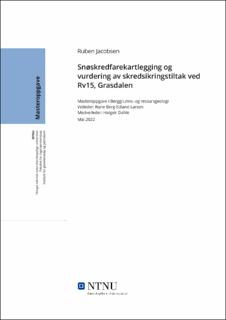| dc.description.abstract | Rv15 gjennom Grasdalen på Strynefjellet er en av mange skredutsatte vegstrekninger i Norge. Strekningen mellom Grasdalstunnelen og Oppljostunnelen har vist seg å være spesielt skredutsatt. Analyser av historiske skredhendelser viser at det er registrert 53 snøskred i vegen langs strekningen siden anleggsarbeidet startet i 1973.
I denne oppgaven kartlegges faren for snøskred langs vegstrekningen mellom Grasdalstunnelen og Oppljostunnelen i Grasdalen i Stryn. Faresonene relateres til Statens vegvesen (2021) sine krav til sikkerhet mot skred i Håndbok N200. Akseptabel risiko for skred langs denne vegstrekningen er 1/50 per km per år i områder hvor trafikken er i flyt.
Oppgaven drøfter videre ulike fysiske tiltak som vil kunne øke sikkerheten mot skred på vegen. De fysiske tiltakene som vurderes er en fangvoll, aktiv snøskredkontroll ved hjelp av snøskredtårn og lysregulering av vegstrekningen ved automatisk skreddeteksjon.
Skredfaren i kartleggingsområdet vurderes på bakgrunn av feltarbeid, analyser av historiske skredhendelser, GIS-analyser og skredsimuleringer i RAMMS:: Avalanche. Det konkluderes med at 700 m av den totalt 900 m lange vegstrekningen i dagen ligger i områder med en årlig sannsynlighet for snøskred ≥1/10 per km, mens hele vegstrekningen ligger i områder med en årlig sannsynlighet ≥1/50 per km.
I vurderingen av en fangvolls effekt som skredsikringstiltak, benyttes skredhastigheter og strømningsmønstre fra skredsimuleringer i RAMMS:: Avalanche ved dimensjoneringen av en 18 m høy og 225 m lang fangvoll. Vollen inkluderes i en terrengmodell av den snødekte skredbanen. Terrengmodellen brukes videre i skredsimuleringsverktøyet RAMMS:: Avalanche hvor fagvollens innvirkning på skredmassene i utløpsområdet vurderes.
Av de tre vurderte skredsikringstiltakene er det aktiv snøskredkontroll ved hjelp av snøskredtårn som gir best resultater. Ved å bruke syv snøskredtårn ser det ut til å være mulig å øke sikkerheten mot snøskred langs vegstrekningen til 1/50 per km per år. Dette forutsetter at metoden fungerer bra i området, og at anlegget driftes aktivt. Den vurderte fangvollen vil mulig kunne fungere effektivt mot snøskred med en returperiode på opp mot 10 år. Et automatisk skredvarslingsanlegg og lysregulering vil ikke være egnet som skredsikringstiltak i området, da stoppestedene for bilister ikke oppnår krav til sikkerhet mot skred. | |
| dc.description.abstract | The Norwegian national road 15 through Grasdalen on Strynefjellet is one of many road sections in Norway prone to snow avalanches. The section between Grasdalstunnelen and Oppljotunnelen has proven to be particularly prone to avalanches. Analyses of historical avalanche events along the road section shows that 53 avalanches were registered at the road since the start of construction work in 1973.
In this thesis, the risk of avalanches along the road section between Grasdalstunnelen and Oppljostunnelen in Grasdalen in Stryn is surveyed. The result is a hazard map where the danger zones are related to the requirements of the Norwegian Public Roads Administration for safety against avalanches in the manual named “Håndbok N200” (SVV, 2021).Acceptable risk of avalanches along the road section is 1/50 per km per year where the traffic is moving.
The thesis further discusses various physical measures that can increase the safety against avalanches on the road. The physical measures that are considered are, i) catchment walls forming avalanche reservoirs, ii) preventive avalanche release by using avalanche towers and, iii) light regulation of the road section by automatic avalanche detection.
The risk of avalanches in the mapping area has been assessed on the basis of fieldwork, analyses of historical avalanches, GIS analyses and avalanche simulations using RAMMS:: Avalanche. It is concluded that 700 m of the total 900 m long road section, which does not pass through the avalanche gallery, is in areas with an annual probability of avalanches ≥1/10 per km, while the entire road section is in areas with an annual probability ≥1/50 per km.
As a part of the assessment of a catchment dam's effect as an avalanche protection measure, avalanche speeds and flow patterns from avalanche simulations in RAMMS:: Avalanche was used in the dimensioning of an 18 m high and 225 m long wall forming a catchment dam accommodating the avalanche volume. The dam is included in a high-resolution terrain model of the snow-covered avalanche path. The terrain model is further used in the avalanche simulation tool RAMMS:: Avalanche, where the effect of the catchment dam on the avalanche masses is assessed.
Of the three avalanche protection measures assessed, preventive avalanche release using avalanche towers gives the best results. By using seven avalanche towers, it seems possible to increase safety against avalanches along the road section to 1/50 per km per year. This presupposes that the method works well in the area, and that the towers are actively operated. The catchment dam can possibly be able to function effectively against avalanches with a return period of up to 10 years. An automatic avalanche detection system operating stop lights is not suitable as an avalanche protection measure in the area, because the emergency parking zones for vehicles do not guarantee safety against oncoming avalanches. | |
